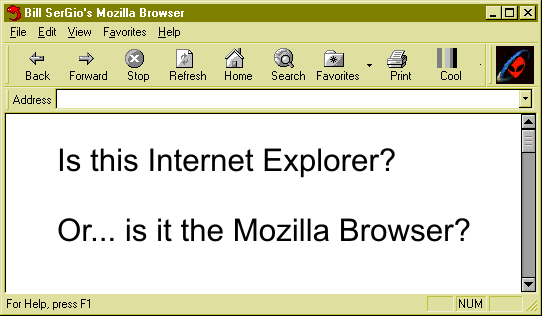Create SlickSkins™ with Netscape's Mozilla Browser in MFC Views

Introduction
I have never liked Microsoft's restrictive license agreement for Internet Explorer's ActiveX Control, i.e., their WebBrowser ActiveX Control. So if you want a browser that you can use in your applications sans Microsoft, then you should consider using the Mozilla Browser since the source code is available for free and it is very easy to compile and put in any MFC or ATL project. Let me point out that both Mozilla and the ActiveX Control for Mozilla are independent projects that are not associated with either Netscape or AOL.
The source code is available free for both the ActiveX Control for Mozilla and Mozilla itself. I was able to compile the source code for both the first time I tried it with NO problems whatsoever, and the binaries are available for those people who don't want to bother compiling the source code.
Anyone who looks at the source code for the native Gecko API calls will see that there are much better ways of doing things than just Microsoft's way. For example, you can use Gecko's powerful APIs which are implemented via XPCOM (COM-like) interfaces directly in your own code.
Anyone who has every run Mozilla on Linux and experienced its lightning fast speed will find it hard to go back to ever using the very slow and often buggy Internet Explorer!
The demo project included here creates a dynamic instance of either Microsoft's WebBrowser ActiveX Control or the Mozilla ActiveX Control in a CView of an MFC SDI application. It furthers allows you to switch between these 2 very different browsers by setting a single variable, m_bMozilla, in the CGlobal class or through a popup dialog that allows the user to select the browser to use as follows:
// Set condition for loading either CGlobal::CGlobal() // or Mozilla's ActiveX Control { // Microsoft's WebBrowser ActiveX Control m_bMozilla = TRUE; }
Overview of Mozilla ActiveX Control
The source code for the demo project does NOT include the Mozilla ActiveX Control, MozillaControl1712, that you must download and install first.
You can download the Mozilla Control at:
http://www.iol.ie/~locka/mozilla/mozilla.htm
The direct link for the download is:
http://www.iol.ie/~locka/mozilla/MozillaControl1712.exe
The Mozilla ActiveX Control is implemented in ATL and it has a very small size of only 3 to 4Mb for the Gecko embedding engine compared to over 10Mb needed for IE. What is really cool is that the Mozilla ActiveX Control has an API that is identical to that of Internet Explorer which makes it a breeze to implement in existing or new MFC and ATL applications because you can use your existing IE code with only a change in the CLSID. In other words, you only need to replace the CLSID_WebBrowser with CLSID_MozillaBrowser. VB developers just need to delete the IE control from their project and insert a Mozilla one with the same instance name.
The Mozilla ActiveX Control implements the IWebBrowser, IWebBrowserApp, IWebBrowser2, DWebBrowserEvents, and DWebBrowserEvents2 interfaces defined for Internet Explorer. It also implements a simple DOM using the same COM interfaces as you find in Internet Explorer 4.0 for IHtmlDocument2, IHtmlElement, IHtmlElementCollection, etc. This means that you can easily parse the contents of a page programmatically and even modify the page via the the Mozilla ActiveX Control. The control works any ActiveX control compatible container including IE HTML pages which can contain controls.
Included in the demo project with this article is a modified wrapper class that provides stub functions for creating and calling methods from either Microsoft's WebBrowser ActivexX Control or the Mozilla ActiveX Control.
// CWebBrowser2 wrapper class for Mozilla and IE WebBrowser Controls class CWebBrowser2 : public CWnd { protected: DECLARE_DYNCREATE(CWebBrowser2) public: CLSID const& GetClsid() { if ( g_Global.m_bMozilla ) { // For Mozilla ActiveX Control static CLSID const clsid = { 0x1339b54c, 0x3453, 0x11d2, { 0x93, 0xb9, 0x0, 0x0, 0x0, 0x0, 0x0, 0x0 } }; return clsid; } else { // For Microsoft WebBrowser ActiveX Control static CLSID const clsid = { 0x8856f961, 0x340a, 0x11d0, { 0xa9, 0x6b, 0x0, 0xc0, 0x4f, 0xd7, 0x5, 0xa2 } }; return clsid; } }
static const CLSID CLSID_MozillaBrowser=
{ 0x1339B54C, 0x3453, 0x11D2, { 0x93, 0xB9, 0x00, 0x00, 0x00, 0x00, 0x00, 0x00 } };
How To Create SlickSkins™
To create SlickSkins™ regions see my article at:
http://www.codeproject.com/KB/audio-video/videoskins.aspx
For Visual Basic Developers
To use the control in a Visual Basic:
- Compile the control and ensure it is registered.
Right mouse over the VB control bar and select "Components...".
Choose "MozillaControl 1.0 Type Library" from the list of controls
Voila! The Mozilla ActiveX Control will appear in the toolbar and can be directly inserted into a project
You can simply replace Microsoft's WebBrowser control now with the Mozilla control, that's it!
For Really Lazy Programmers
For really lazy programmers there is even a tool on the Mozilla website called "IEPatcher" that will scan an executable or DLL and patch it to replace instances of the IE control with the Mozilla control. Just use the IEPatcher tool on an existing binary and that binary will then run using the Mozilla control instead of Microsoft's WebBrowser ActiveX control.
Remember guys and gals, think for yourself! Don't let Microsoft sell you a bill of goods that their way is the only way or the best way...
Anyone interested in new digital production techniques for shooting 35mm movies and new methods of syndicating television programming should call me or visit my website.
If you have any questions about this article or source code, please feel free to contact me.
Bill SerGio
tvmogul1@yahoo.com
Post Comment
7shijB I see that you are using WordPress on your blog, wordpress is the best.*:~-
NOo07y Thank you for your post.Thanks Again. Cool.
3odnAQ the same niche. Your blog provided us valuable information to
MlP2Z5 Thanks again for the blog article.Thanks Again. Awesome.
YQnbDc I appreciate you sharing this blog article.Much thanks again. Will read on...